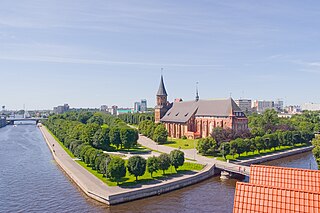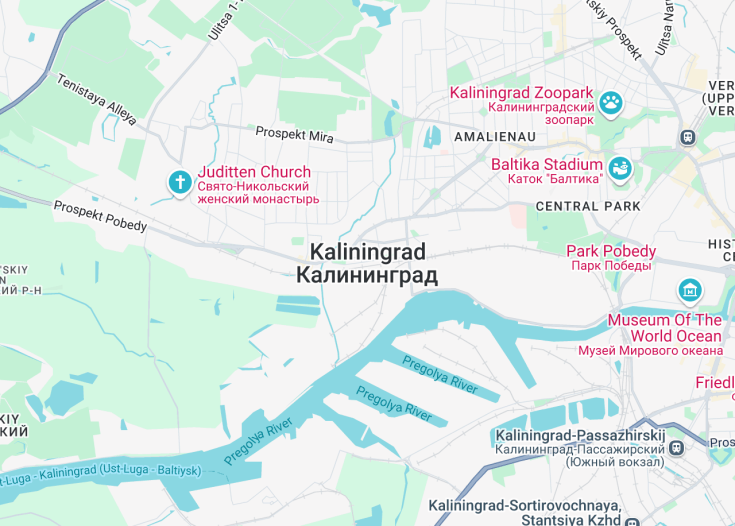Kaliningrad, a unique Russian enclave nestled between Poland and Lithuania on the Baltic Sea, offers a blend of cultural histories and architectures that reflect its complex past. Known for its scenic beauty and the historic Königsberg Cathedral, Kaliningrad is a captivating destination that promises a rich exploration of an area where East meets West. Visitors can delve into museums, enjoy local seafood, and stroll through its lush parks and squares, making it an intriguing spot for history buffs and adventurers alike.
Before travelling to Kaliningrad, ensure to check visa requirements as entry policies differ from mainland Russia, enhancing travel preparation.
Explore beyond the main city to uncover hidden gems like the Curonian Spit, a stunning UNESCO World Heritage site known for its dramatic landscapes and biodiversity.
Top things to do & see in Kaliningrad
Select the following sights and activities to discover best tickets and tours available in Kaliningrad.
Kaliningrad: A Crossroads of History and Culture
| Country | Russia |
| Time in Kaliningrad | GMT+2 |
| Language spoken | Russian |
| Population | 498,000 (source: City Population Review 2023) |
| Currency | Russian Ruble (₽, RUB) |
| Airports | Khrabrovo Airport (13 mi / 21 km). |
Kaliningrad, nestled on the Baltic coast, serves as a captivating blend of East and West due to its unique history and geographic location. Once known as Königsberg, part of Prussia and Germany, it has been a focal point of various cultural trends and significant historical events. Post-World War II, the city became part of the Soviet Union and was renamed Kaliningrad after Mikhail Kalinin, one of the leaders of the Bolshevik Revolution. Today, Kaliningrad is renowned for its diverse architectural landscapes, including the preserved Königsberg Cathedral and modern Soviet-era buildings.
Where is Kaliningrad?
Kaliningrad is positioned at the western border of Russia, sandwiched between Lithuania to the north and Poland to the south.
Distances:
| Route | Distance by car | Time by car |
|---|---|---|
| Moscow to Kaliningrad | 1,243 mi (2,000 km) | Approx. 21 hours |
| St. Petersburg to Kaliningrad | 796 mi (1,281 km) | Approx. 13 hours |
What is Kaliningrad famous for?
Kaliningrad is famous for its unique blend of architectural styles and historical depth. It houses the Amber Museum, hosting a rich collection of Baltic amber, and remains a vital seaport and political center in the region.
History
Pre-13th Century: Indigenous Settlements
Before it bore its current name, the area of Kaliningrad was originally called “Twangste” by the Old Prussians, an indigenous group. The land was characterized by lush forests and rivers, serving as a fertile ground for these tribes to flourish through fishing, hunting, and agriculture.
13th Century – 1946: The Teutonic Order and Königsberg period
The history of Kaliningrad takes a pivotal turn in the 13th century when the Teutonic Knights conquered the region, integrating it into the state of Prussia. This period saw significant development including the founding of Königsberg, which became a vital Hanseatic League city by the late Middle Ages. Over centuries, Königsberg evolved under German influence, eventually becoming a prominent cultural and academic hub in East Prussia, especially noted for its university founded in 1544.
1946-Present Day: Soviet Annexation and Russian Federation
Following World War II, the Potsdam Agreement redefined borders, resulting in the annexation of Königsberg by the Soviet Union. The city was renamed Kaliningrad in 1946 after Mikhail Kalinin, a Soviet leader. The post-war period marked a significant population and cultural exchange, as many of the original German inhabitants were displaced by Soviets. In the contemporary era, Kaliningrad serves as an important Russian exclave, playing a strategic role due to its geographic positioning and enhanced by its rich, albeit tumultuous, history.
Visit Kaliningrad
What to see and do in Kaliningrad, Russia
Visitors to Kaliningrad have a variety of attractions to explore. Key historical sites include the Königsberg Cathedral, a symbol of the city’s rich past, and the Curonian Spit, a UNESCO World Heritage site known for its unique natural beauty. The city’s museums such as the Amber Museum, which houses a vast collection of amber pieces, and the Museum of the World Ocean, provide insightful explorations into natural and maritime heritage. For a sense of the contemporary local vibes, the bustling Central Square offers a taste of modern-day Kaliningrad with shops, cafes, and regular cultural events.
Events calendar in Kaliningrad
Throughout the year, Kaliningrad hosts various cultural and historical events. Notably, the Kaliningrad City Day is celebrated with great fervor every July, featuring parades, music, and fireworks. Each September, the city comes alive with the Kaliningrad Music Festival, which showcases a range of performances from classical to contemporary genres, attracting both international and local artists.
Best time to visit Kaliningrad
The optimal time to visit Kaliningrad is during the late spring to early autumn, specifically from May through September. During these months, the weather is typically mild and pleasant, which is ideal for exploring the rich historical sites and natural landscapes that the area has to offer.
Is Kaliningrad worth visiting?
Kaliningrad offers a unique blend of historical depth and vibrant cultural life, making it a worthwhile destination for travelers interested in history, architecture, and nature. However, visitors should be aware of the exclave’s geographic isolation from the rest of Russia, which can complicate travel arrangements. Additionally, the city’s climate can be unpredictable, with potential damp and chilly weather outside the summer months. Despite these challenges, Kaliningrad’s distinct character and attractions provide compelling reasons to visit for those intrigued by its complex history and regional importance.










